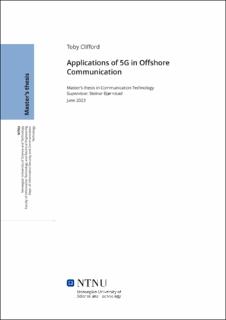| dc.contributor.advisor | Bjørnstad, Steinar | |
| dc.contributor.author | Clifford, Toby | |
| dc.date.accessioned | 2023-09-19T17:19:35Z | |
| dc.date.available | 2023-09-19T17:19:35Z | |
| dc.date.issued | 2023 | |
| dc.identifier | no.ntnu:inspera:146715749:98308096 | |
| dc.identifier.uri | https://hdl.handle.net/11250/3090573 | |
| dc.description.abstract | Det lanseres non-standalone 5G-nettverk i Norge som neste steg i overgangsperioden fra standalone LTE til standalone 5G. Vi analyserer hvordan 5G kan brukes offshore – for eksempel på olje- og gassplattformer, for å tilrettelegge nye brukstilfeller hvor ytelseskravene ikke oppfylles av LTE. Vi drøfter tre applikasjonsområder innen 5G; Enhanced Mobile Broadband (eMBB), Massive Machine-Type Communications (mMTC), og Ultra-Reliable Low Latency Communications (URLLC). Endringer i 5G-spesifikajsonene – som spesifiseringen av bruk av millimetre wave for overføring, massive MIMO og beamforming og en fleksibel rammestruktur, fører til at disse applikasjonsområdene kan bli realisert.
Vi presenterer et brukstilfelle som bruker AR og VR til å forbedre vedlikeholdsprosessen av offshore-plattformer. Brukstilfellet består av tre deler. Den første delen består av et ekstra lag av grafikk over brukerens synsfelt som kan gi brukeren informasjonen om og manualen til en maskin som brukeren har i synsfeltet. Den andre delen innebærer å skape en mer interaktiv opplevelse av toveiskommunikasjonen mellom brukeren og eksperter som befinner seg onshore. Den siste delen handler om opplæring av nye brukere ved hjelp av VR-modeller. Dette brukstilfellet tilbyr flere Quality-of-Experience (QoE) nivåer, hvert med sine ytelseskrav.
Vi gjennomfører et eksperiment for å måle båndbredden og forsinkelsen i et standalone og et non-standalone nettverk for å finne ut om dagens 5G-nettverk oppfyller ytelseskravene av AR/VR- brukstilfellet. Resultatene viser at gjennomstrømmingskravet for nedlink ble oppfylt for et lavt QoE nivå, men den målte opplink-gjennomstrømningen ble imidlertid ikke høy nok. Det var store forskjeller på den målte nedlink-gjennomstrømningen mellom de ulike basestasjonene og mellom standalone-nettverket og non-standalone-nettverket. Ingen av nettverkene oppfylte forsinkelseskravene til AR/VR-brukstilfellet. Resultatene viste at den laveste forsinkelsen ble oppnådd ved bruk av et standalone nettverk og en lokal server plassert i 5G-kjernen.
Videre anerkjenner vi at gjeldende tildeling av frekvensbånd til mobilkommunikasjon i Norge begrenser det fulle potensialet av 5G offshore. Nasjonal kommunikasjonsmyndighet (NKOM) planlegger imidlertid å tildele 26 GHz-båndet til mobilnettoperatører i slutten av 2023. I tillegg tilrettelegger NKOM for lokale mobilnett med tilpassede rammestrukturer. Disse endringene kan føre til økt gjennomstrømning og lavere forsinkelse i 5G-nettverk i fremtiden. | |
| dc.description.abstract | Non-standalone 5G networks are being rolled out across Norway as a stepping stone in transitioning from standalone LTE to standalone 5G. We explore how 5G can be used in an offshore environment, such as on oil and gas platforms, to enable new use cases with performance requirements that LTE is unable to fulfil. We discuss three classes of use cases for 5G: Enhanced Mobile Broadband (eMBB), Massive Machine-Type Communications (mMTC), and Ultra-Reliable Low Latency Communications (URLLC) and explore how they are enabled by changes in the 5G specifications including millimetre wave transmissions, massive MIMO and beamforming, and a flexible frame structure.
We present a use case which involves AR and VR solutions to improve the maintenance process of offshore platforms. The use case consists of three parts. The first part involves overlaying graphics onto the user's field of view including information about the machine the user is looking at, as well as safety and maintenance manuals. The second part provides a more interactive two-way communications experience with experts onshore. The third part compliments the employee training process with the use of VR models. The use case offers multiple Quality-of-Experience (QoE) levels, each with its own performance requirements.
We perform an experiment to measure the bandwidth and latency of a standalone and a non-standalone 5G network to determine whether current 5G networks can meet the performance requirements of the AR/VR use case. Results show that the downlink throughput requirement was met for a low QoE level, however, the measured uplink throughput was not high enough. There were large variations in downlink throughput between the base stations tested and between the standalone and non-standalone networks. None of the 5G networks tested met the latency requirements for the AR/VR use case. The results showed that the lowest latency was achieved when using a standalone network and a local server located in the 5G core.
Furthermore, we acknowledge that the current frequency allocation for mobile communication networks in Norway limits the full potential of 5G offshore. However, the Norwegian Communications Authority (NKOM) plans to allocate the 26 GHz frequency band to mobile network operators at the end of 2023, as well as allow for local 5G networks with custom frame structures. Both developments can enable higher throughput and lower latency in future 5G networks. | |
| dc.language | eng | |
| dc.publisher | NTNU | |
| dc.title | Applications of 5G in Offshore Communication | |
| dc.type | Master thesis | |
